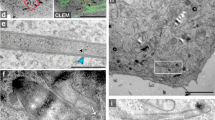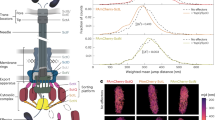Abstract
Type III secretion (T3S) systems are key features of many gram-negative bacteria that translocate T3S effector proteins directly into eukaryotic cells. There, T3S effectors exert many effects, such as cellular invasion or modulation of host immune responses. Studying spatiotemporal orchestrated secretion of various effectors has been difficult without disrupting their functions. Here we developed a new approach using Shigella flexneri T3S as a model to investigate bacterial translocation of individual effectors via multidimensional time–lapse microscopy. We demonstrate that direct fluorescent labeling of tetracysteine motif–tagged effectors IpaB and IpaC is possible in situ without loss of function. Studying the T3S kinetics of IpaB and IpaC ejection from individual bacteria, we found that the entire pools of IpaB and IpaC were released concurrently upon host cell contact, and that 50% of each effector was secreted in 240 s. This method allows an unprecedented analysis of the spatiotemporal events during T3S.
This is a preview of subscription content, access via your institution
Access options
Subscribe to this journal
Receive 12 print issues and online access
$259.00 per year
only $21.58 per issue
Buy this article
- Purchase on Springer Link
- Instant access to full article PDF
Prices may be subject to local taxes which are calculated during checkout





Similar content being viewed by others
References
Hueck, C.J. Type III protein secretion systems in bacterial pathogens of animals and plants. Microbiol. Mol. Biol. Rev. 62, 379–433 (1998).
Cornelis, G.R. & Van Gijsegem, F. Assembly and function of type III secretory systems. Annu. Rev. Microbiol. 54, 735–774 (2000).
Lafont, F., Tran Van Nhieu, G., Hanada, K., Sansonetti, P. & van der Goot, F.G. Initial steps of Shigella infection depend on the cholesterol/sphingolipid raft-mediated CD44-IpaB interaction. EMBO J. 21, 4449–4457 (2002).
Gruenheid, S. & Finlay, B.B. Microbial pathogenesis and cytoskeletal function. Nature 422, 775–781 (2003).
Sansonetti, P.J. Rupture, invasion and inflammatory destruction of the intestinal barrier by Shigella, making sense of prokaryote-eukaryote cross-talks. FEMS Microbiol. Rev. 25, 3–14 (2001).
Sory, M.P. & Cornelis, G.R. Translocation of a hybrid YopE–adenylate cyclase from Yersinia enterocolitica into HeLa cells. Mol. Microbiol. 14, 583–594 (1994).
Day, J.B., Ferracci, F. & Plano, G.V. Translocation of YopE and YopN into eukaryotic cells by Yersinia pestis yopN, tyeA, sycN, yscB and lcrG deletion mutants measured using a phosphorylatable peptide tag and phosphospecific antibodies. Mol. Microbiol. 47, 807–823 (2003).
Charpentier, X. & Oswald, E. Identification of the secretion and translocation domain of the enteropathogenic and enterohemorrhagic Escherichia coli effector Cif, using TEM-1 beta-lactamase as a new fluorescence-based reporter. J. Bacteriol. 186, 5486–5495 (2004).
Rosqvist, R., Magnusson, K.E. & Wolf-Watz, H. Target cell contact triggers expression and polarized transfer of Yersinia YopE cytotoxin into mammalian cells. EMBO J. 13, 964–972 (1994).
Mounier, J., Bahrani, F.K. & Sansonetti, P.J. Secretion of Shigella flexneri Ipa invasins on contact with epithelial cells and subsequent entry of the bacterium into cells are growth stage dependent. Infect. Immun. 65, 774–782 (1997).
Cain, R.J., Hayward, R.D. & Koronakis, V. The target cell plasma membrane is a critical interface for Salmonella cell entry effector-host interplay. Mol. Microbiol. 54, 887–904 (2004).
Jacobi, C.A. et al. In vitro and in vivo expression studies of yopE from Yersinia enterocolitica using the gfp reporter gene. Mol. Microbiol. 30, 865–882 (1998).
Buchrieser, C. et al. The virulence plasmid pWR100 and the repertoire of proteins secreted by the type III secretion apparatus of Shigella flexneri. Mol. Microbiol. 38, 760–771 (2000).
Menard, R., Sansonetti, P. & Parsot, C. The secretion of the Shigella flexneri Ipa invasins is activated by epithelial cells and controlled by IpaB and IpaD. EMBO J. 13, 5293–5302 (1994).
Blocker, A. et al. The tripartite type III secreton of Shigella flexneri inserts IpaB and IpaC into host membranes. J. Cell Biol. 147, 683–693 (1999).
Tran Van Nhieu, G., Caron, E., Hall, A. & Sansonetti, P.J. IpaC induces actin polymerization and filopodia formation during Shigella entry into epithelial cells. EMBO J. 18, 3249–3262 (1999).
Ohya, K., Handa, Y., Ogawa, M., Suzuki, M. & Sasakawa, C. IpgB1 is a novel Shigella effector protein involved in bacterial invasion of host cells: Its activity to promote membrane ruffling via RAC1 and CDC42 activation. J. Biol. Chem. 280, 24022–24034 (2005).
Yoshida, S. et al. Shigella deliver an effector protein to trigger host microtubule destabilization, which promotes Rac1 activity and efficient bacterial internalization. EMBO J. 21, 2923–2935 (2002).
Bourdet-Sicard, R. et al. Binding of the Shigella protein IpaA to vinculin induces F-actin depolymerization. EMBO J. 18, 5853–5862 (1999).
Adams, S.R. et al. New biarsenical ligands and tetracysteine motifs for protein labeling in vitro and in vivo: synthesis and biological applications. J. Am. Chem. Soc. 124, 6063–6076 (2002).
Tsien, R.Y. Building and breeding molecules to spy on cells and tumors. FEBS Lett. 579, 927–932 (2005).
Gaietta, G. et al. Multicolor and electron microscopic imaging of connexin trafficking. Science 296, 503–507 (2002).
Ignatova, Z. & Gierasch, L.M. Monitoring protein stability and aggregation in vivo by real-time fluorescent labeling. Proc. Natl. Acad. Sci. USA 101, 523–528 (2004).
Cambronne, E.D., Sorg, J.A. & Schneewind, O. Binding of SycH chaperone to YscM1 and YscM2 activates effector yop expression in Yersinia enterocolitica. J. Bacteriol. 186, 829–841 (2004).
Guzman, L.M., Belin, D., Carson, M.J. & Beckwith, J. Tight regulation, modulation, and high-level expression by vectors containing the arabinose PBAD promoter. J. Bacteriol. 177, 4121–4130 (1995).
Barzu, S., Benjelloun-Touimi, Z., Phalipon, A., Sansonetti, P. & Parsot, C. Functional analysis of the Shigella flexneri IpaC invasin by insertional mutagenesis. Infect. Immun. 65, 1599–1605 (1997).
Schuch, R., Sandlin, R.C. & Maurelli, A.T. A system for identifying post-invasion functions of invasion genes: requirements for the Mxi-Spa type III secretion pathway of Shigella flexneri in intercellular dissemination. Mol. Microbiol. 34, 675–689 (1999).
Clerc, P.L., Ryter, A., Mounier, J. & Sansonetti, P.J. Plasmid-mediated early killing of eucaryotic cells by Shigella flexneri as studied by infection of J774 macrophages. Infect. Immun. 55, 521–527 (1987).
Allaoui, A., Sansonetti, P.J. & Parsot, C. MxiD, an outer membrane protein necessary for the secretion of the Shigella flexneri lpa invasins. Mol. Microbiol. 7, 59–68 (1993).
Dumenil, G. et al. Interferon alpha inhibits a Src-mediated pathway necessary for Shigella-induced cytoskeletal rearrangements in epithelial cells. J. Cell Biol. 143, 1003–1012 (1998).
Schlumberger, M.C. et al. Real-time imaging of type III secretion: Salmonella SipA injection into host cells. Proc. Natl. Acad. Sci. USA 102, 12548–12553 (2005).
Parsot, C., Menard, R., Gounon, P. & Sansonetti, P.J. Enhanced secretion through the Shigella flexneri Mxi-Spa translocon leads to assembly of extracellular proteins into macromolecular structures. Mol. Microbiol. 16, 291–300 (1995).
Acknowledgements
We thank C. Parsot for reagents and helpful discussions, and we acknowledge all other members of P. Sansonetti's laboratory for their support. Furthermore, we thank P. Roux, M. Marchand and S. Shorte at the “Plate-forme d'Imagerie Dynamique” (PFID) at the Institut Pasteur for invaluable experimental help, discussion and advice on data processing. Finally, we are grateful to M. Mavris and J. Rohde for critically reading the manuscript, and to K. Schauer for help with the figure layout. P.S. is a Howard Hughes International Scholar, and J.E. received successive fellowships from the Fondation pour la Recherche Médicale (FRM), the European Molecular Biology Organization (EMBO) and the Human Frontiers Science Program (HFSP).
Author information
Authors and Affiliations
Corresponding authors
Ethics declarations
Competing interests
The authors declare no competing financial interests.
Supplementary information
Supplementary Fig. 1
Fusion between IpaC and EGFP prevents the secretion of the resulting protein chimera and of other type III effectors. (PDF 519 kb)
Supplementary Fig. 2
Fluorescent labelling of bacterial proteins with biarsenic components. (PDF 578 kb)
Supplementary Fig. 3
Fluorescent labelling of intrabacterial IpaB–4Cys and IpaC–4Cys is dependent on the FlAsH concentration. (PDF 789 kb)
Supplementary Fig. 4
IpaB–4Cys or IpaC–4Cys are secreted with similar efficiencies independently of FlAsH-incorporation. (PDF 961 kb)
Supplementary Fig. 5
Ethanedithiol (EDT) negatively affects T3S mediated cellular invasion by Shigella flexneri. (PDF 414 kb)
Supplementary Fig. 6
The appearance of actin foci formation occurs with similar kinetics for M90T, ipaB/IpaB–4Cys, and ipaC/IpaC–4Cys. (PDF 221 kb)
Supplementary Video 1
Time lapse of IpaB secretion. (MOV 616 kb)
Rights and permissions
About this article
Cite this article
Enninga, J., Mounier, J., Sansonetti, P. et al. Secretion of type III effectors into host cells in real time. Nat Methods 2, 959–965 (2005). https://doi.org/10.1038/nmeth804
Received:
Accepted:
Published:
Issue Date:
DOI: https://doi.org/10.1038/nmeth804
This article is cited by
-
Cytosolic sorting platform complexes shuttle type III secretion system effectors to the injectisome in Yersinia enterocolitica
Nature Microbiology (2024)
-
Visualizing the dynamics of exported bacterial proteins with the chemogenetic fluorescent reporter FAST
Scientific Reports (2020)
-
Bacterial virulence mediated by orthogonal post-translational modification
Nature Chemical Biology (2020)
-
LITESEC-T3SS - Light-controlled protein delivery into eukaryotic cells with high spatial and temporal resolution
Nature Communications (2020)
-
Protein polarization driven by nucleoid exclusion of DnaK(HSP70)–substrate complexes
Nature Communications (2018)



